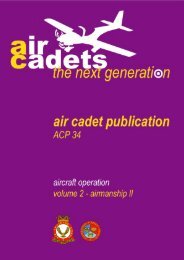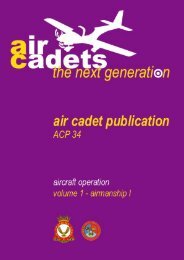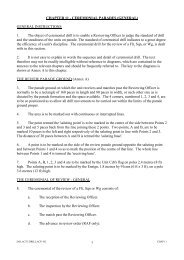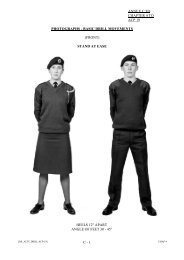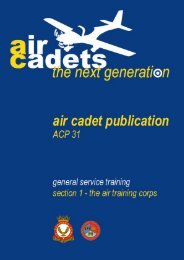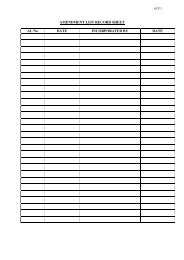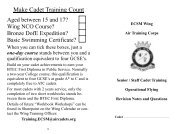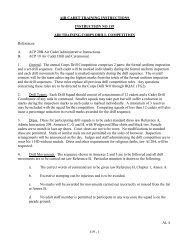Leading Cadet ECSM Wing Revision Guide - 967 Air Cadets
Leading Cadet ECSM Wing Revision Guide - 967 Air Cadets
Leading Cadet ECSM Wing Revision Guide - 967 Air Cadets
Create successful ePaper yourself
Turn your PDF publications into a flip-book with our unique Google optimized e-Paper software.
Finding North without a Compass<br />
In the northern hemisphere the direction of the<br />
north pole is indicated by the position of the Pole<br />
Star. This can be found by following the pointers<br />
in the group of stars known as the Great Bear or<br />
Plough.<br />
Why is it important to set a map before using it in the<br />
field?<br />
a) So that a compass can be used to follow the required<br />
direction over the ground.<br />
b) So that distances can be measured more easily.<br />
c) So that features on the ground seen by the observer can<br />
be easily related to features on the map.<br />
d) So that names printed on the map may be read more<br />
easily.<br />
Which star group can be used to find the Pole Star?<br />
CHAPTER 5 GLIDING<br />
You will recall that when an aircraft is in steady<br />
straight and level flight the four forces balance,<br />
lift = weight and thrust = drag. If the engine(s)<br />
were to be switched off or fail , the pilot would<br />
have to put the aircraft into a descent to maintain<br />
airspeed and prevent the aircraft stalling. He is<br />
using an element of the weight vector to replace<br />
thrust. This is how gliders fly.<br />
Name the three forces acting on a glider in steady balanced<br />
flight.<br />
a) Drag, thrust and lift.<br />
b) Drag, weight and lift.<br />
c) Drag, weight and thrust.<br />
d) Thrust, weight and lift.<br />
A glider with a gliding angle of 1 in 40 is in still air and<br />
flying over level ground. What distance will the aircraft<br />
travel from a height of 1640 feet (0.5 km) before reaching<br />
the ground?<br />
a) Orion's Belt. b) The Crab Nebula.<br />
c) The Great Bear. d) The Milky Way.<br />
Lift<br />
a) 10 kms b) 20 kms<br />
c) 40 kms d) 80 kms<br />
Using an analogue watch, point the hour hand at<br />
the sun and bisect the angle between the hour hand<br />
and the twelve o’clock position. This line points<br />
due south. (Use the one o’clock position during<br />
British Summer Time.)<br />
North<br />
South<br />
SUN<br />
To use the shadow method, place a stick in the<br />
ground and mark the end of its shadow with a<br />
small stone. After 10 to15 minutes use a second<br />
stone to mark the end of the stick’s shadow again.<br />
A line between the two stones runs roughly west to<br />
east, and a line at right angles to that will run north<br />
to south, north being the point away from the stick.<br />
East<br />
West<br />
From the diagram of the<br />
star constellation The<br />
Plough, which letter<br />
indicates the correct<br />
position of the Pole Star?<br />
a) W b) X<br />
c) Y d) Z<br />
When using a watch to find north/south, what should be<br />
pointed towards the sun?<br />
a) The 12 of the watch face. b) The second hand.<br />
c) The minute hand. d) The hour hand.<br />
You are on the Isle of Wight on<br />
21 November at 4 pm (GMT) and<br />
you hold your watch flat and<br />
correctly aligned as in the previous<br />
question, which arrow will be<br />
pointing north?<br />
a) E b) F<br />
c) G d) H<br />
While on expedition in South<br />
Wales a cadet places a stick in<br />
the ground and watches the<br />
shadow move from position 1<br />
to position 2. Which arrow<br />
points north?<br />
a) W.<br />
b) X.<br />
c) Y.<br />
d) Z.<br />
Which of the following is not a method for determining<br />
north without a compass?<br />
a) Using the shadow from a stick.<br />
b) Using a watch with the sun.<br />
c) Finding the pole star from The Plough.<br />
d) Finding wind direction.<br />
Path of<br />
glider<br />
The Viking glider has a gliding angle of approximately<br />
1 in 35. This means that from a height of 1<br />
kilometre (3,280 feet) it will travel 35 kilometres<br />
in still air conditions before touching down. A<br />
high performance glider with a glide angle of 1 in<br />
40 will travel 40 km from the same height or just<br />
20 km from a height of 0.5 kilometre (1640 ft).<br />
As gliders fly so slowly, any wind has a significant<br />
effect on their performance. A glider flying at<br />
35 kts with a 35 kt tailwind will have a speed over<br />
the ground of 70 kts. If the glider then turns into<br />
the wind it would have a groundspeed of zero kts<br />
and to an observer on the ground would appear to<br />
lose height over the same spot.<br />
<strong>Air</strong>brakes<br />
Weight<br />
Instead of flaps, most gliders are fitted with airbrakes.<br />
These are panels which are normally flush<br />
with the upper and lower surfaces of the wings but<br />
when selected by the pilot pop out of the wings at<br />
90° to the surface where they interfere with the<br />
airflow considerably increasing drag. To maintain<br />
airspeed the pilot lowers the nose, increasing the<br />
gliding angle and allowing him to land in a much<br />
smaller space than would otherwise be possible.<br />
A glider with a gliding angle of 1 in 20 is in still air and<br />
flying over level ground. What distance will the aircraft<br />
travel from a height of 1640 feet (0.5 km) before reaching<br />
the ground?<br />
a) 5 kms b) 10 kms<br />
c) 20 kms d) 8.75 kms<br />
A glider with a gliding angle of 1 in 30 is in still air and<br />
flying over level ground. What distance will the aircraft<br />
travel from a height of 1640 feet (0.5 km) before reaching<br />
the ground?<br />
a) 15 kms b) 25 kms<br />
c) 30 kms d) 60 kms<br />
A glider with a gliding angle of 1 in 35 is in still air and<br />
flying over level ground. What distance will the aircraft<br />
travel from a height of 1640 feet (0.5 km) before reaching<br />
the ground?<br />
a) 8.75 kms b) 17.5 kms<br />
c) 35 kms d) 70 kms<br />
A glider with a flying speed of 35 kts flies into a head<br />
wind of 35 kts. To an observer on the ground the glider<br />
will appear to:<br />
a) Cover the ground at 35 kts.<br />
b) Lose height slowly over one spot.<br />
c) Cover the ground at 70 kts.<br />
d) Climb steadily.<br />
When would a glider pilot use airbrakes?<br />
a) When wanting to climb.<br />
b) When approaching to land.<br />
c) When wanting to turn.<br />
d) When being winch-launched.<br />
The action of airbrakes on the wings of a glider is to:<br />
a) Increase lift and increase drag.<br />
b) Increase lift and reduce drag.<br />
c) Reduce lift and increase drag.<br />
d) Reduce lift and reduce drag.<br />
28<br />
13



